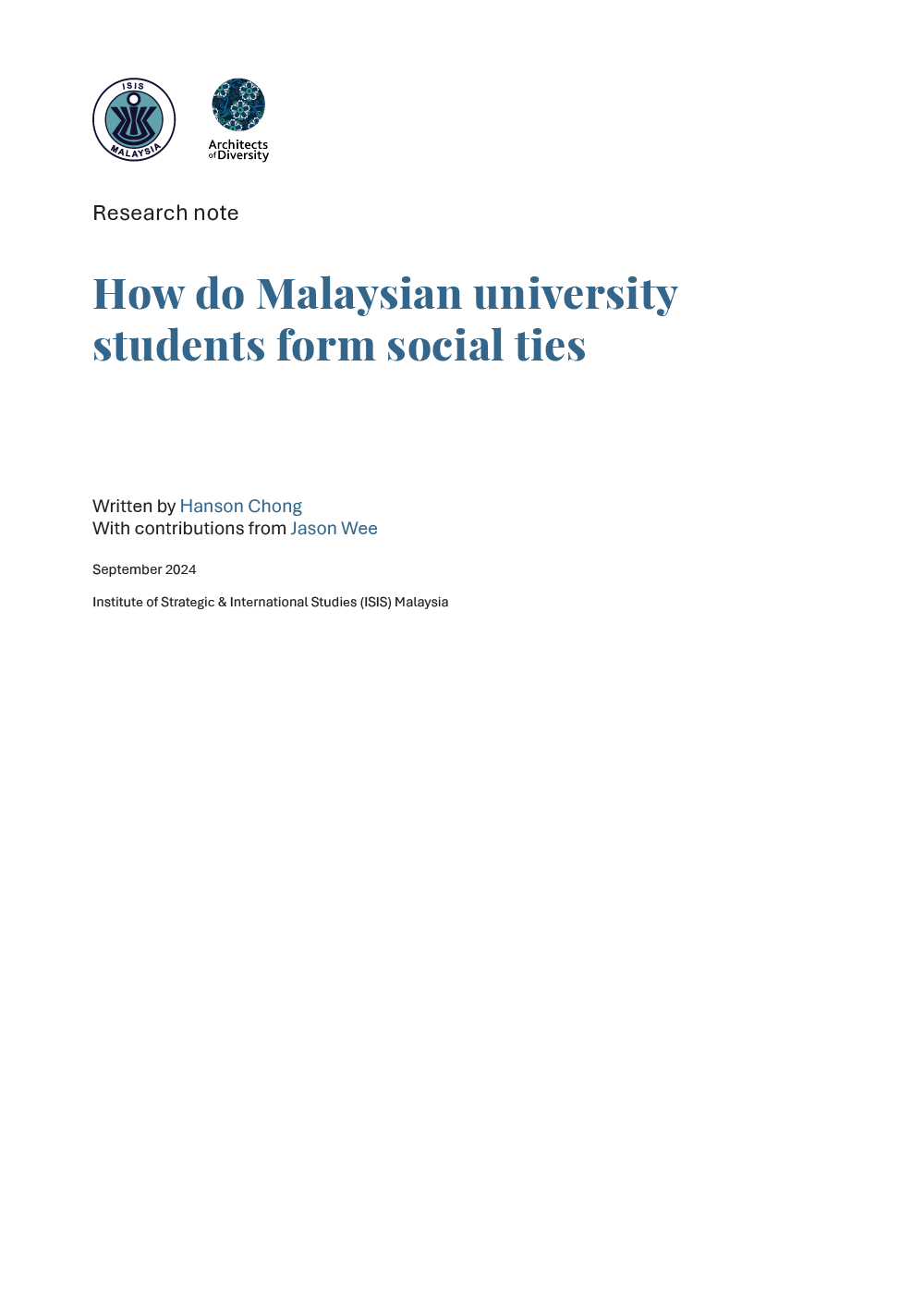Written by Hanson Chong
With contributions from Jason Wee
September 2024
About the contributors
Hanson Chong is a researcher in the Economics, Trade and Regional Integration programme at the Institute of Strategic & International Studies (ISIS) Malaysia. He is a quantitative researcher primarily employing social network analysis and impact evaluation methods. He graduated from the London School of Economics and Political Science (LSE) with an MSc in Social Research Methods under the Khazanah Postgraduate Global Scholarship and completed his BSc (Hons) Economics at the University of Nottingham Malaysia.
Jason Wee is the executive director of Architects of Diversity, a non-profit organisation that works towards building a peaceful, equitable and inclusive Malaysia. In his current role, he oversees thought leadership and research on social cohesion and anti-discrimination in the context of racial and religious relations. He has led various research projects including national surveys on attitudes towards intergroup relations, discrimination and national policies. Jason holds a Bachelor of Arts in Public and International Affairs from Princeton University.
Executive summary
- This research note studies the determinants of four types of social ties between Malaysian university students using two sets of complete network data, one from a public university and one from a private university.
- Statistical analysis of the social networks reveals that ethnic, gender and language homophily have a significant effect on social-tie formation. That is, students of the same ethnicity, who speak the same language or who identify as the same gender are more likely to form social ties with each other. However, these effects differ between the public and private university social networks and according to the type of social tie.
- Further analysis of the factors that moderate ethnic homophily suggests that speaking Bahasa Malaysia reduces the tendency to form same-ethnicity social ties while growing up in a district with a higher concentration of residents of the same ethnicity enhances this tendency.
- These findings expand the evidence base showing that ethnic and language homophily are important factors that shape social-tie formation and highlight language and geography as important factors to consider in formulating policies for social cohesion.
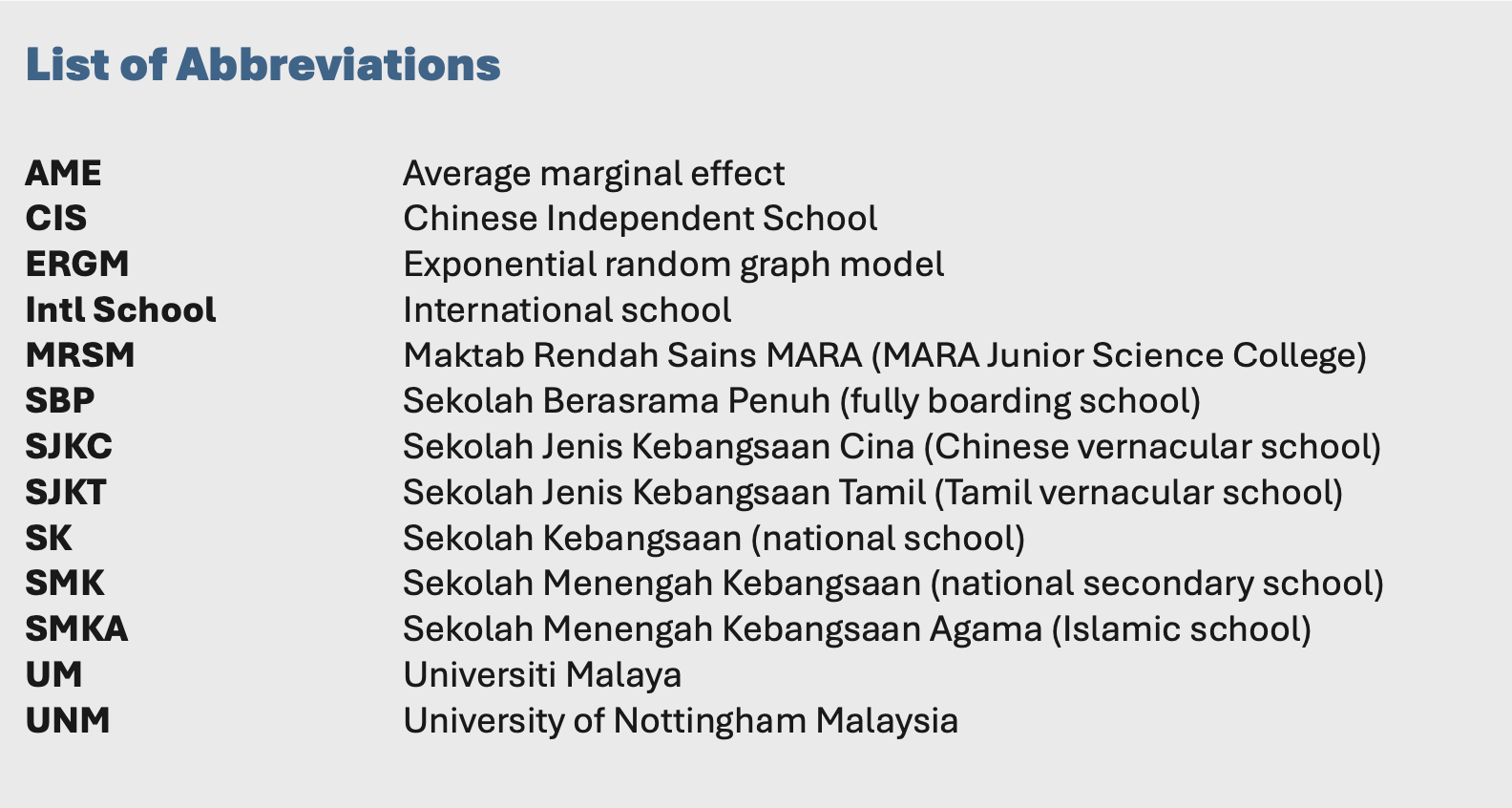
- Introduction and background
Birds of a feather flock together. This expression highlights the universal observation that people tend to associate with others similar to them.1 This phenomenon, known as “homophily,” describes the tendency of individuals to form social ties with those who share similar physical and social traits. Homophily is widely observed across different populations across the world. 2,3
Homophily in social relations can have significant consequences for social cohesion. When people form social networks based on similarities, information and resources circulate within homogeneous groups instead of being shared across a wider, more diverse population.4 Consequently, group membership determines individuals’ access to opportunities and, in the long term, socioeconomic outcomes of different groups could diverge.5 This widening inequality between groups fuels social tension and undermines social cohesion.
Despite the importance of studying the social tie formation behaviour of individuals and its implications on the social fabric of a nation, there is a paucity of empirical analysis of social networks in Malaysia.6,7 This research note aims to fill this gap by studying what how Malaysian university students form social ties.
To guide the inquiry, we start with the premise that the value of a social tie is largely unknown and individuals form social ties weighing the expected benefits and known costs. In a utility-maximisation framework, shared traits reduce the cost of social tie formation due to familiarity and shared experiences.8 Thus, we examine how sharing a common ethnicity, language and gender affects social tie formation among Malaysian university students. The empirical strategy of this research note is to analyse two sets of complete network data using a statistical model of social network analysis which accounts for social interactions across entire networks without relying on sampling assumptions.9
This research note answers two sets of questions. First, it identifies variables that are statistically significant in predicting social ties between university students. To this end, homophily across ethnicity, language and gender are found to be significant – however, there are distinctions between public and private universities. Second, it examines the factors that moderate the effect of ethnic homophily. We find that growing up in a district where most residents are of the same ethnicity is associated with stronger ethnic homophily and that speaking the national language reduces the effect of ethnic homophily. These findings suggest that homophilic tendencies are proportional to an individual’s level of ethnic identification.
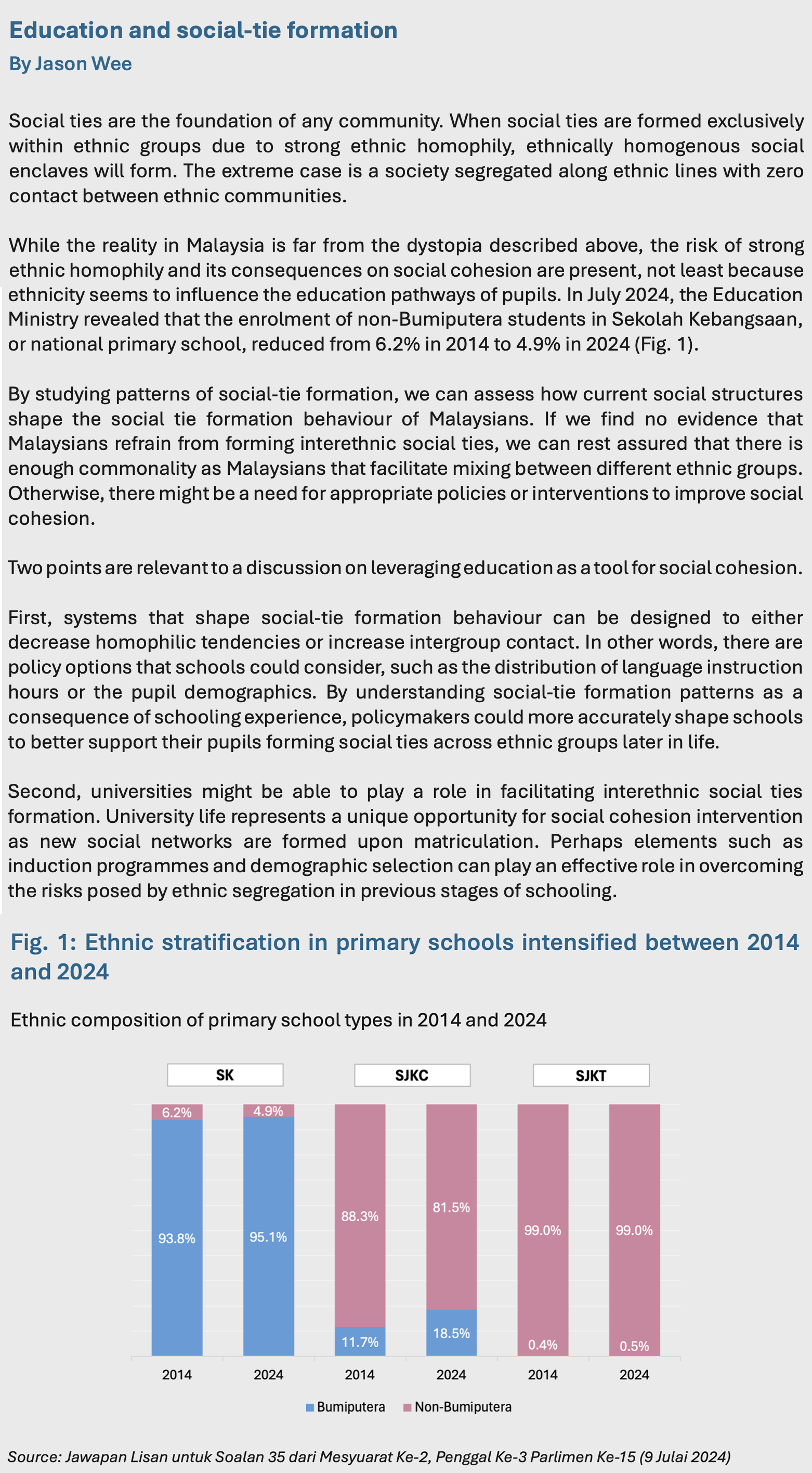
2. Data
The analysis here is based on two sets of complete network data, also known as sociocentric network data.10 The first dataset contains information on 24 final-year students at Universiti Malaya (UM) and four types of social ties between them, while the second dataset contains the same information for 19 final-year students at the University of Nottingham Malaysia (UNM). Both datasets were generated from a survey administered in April 2024. Appendix A elaborates on the survey methodology.
The selection of one public university (i.e. UM) and one private university (i.e. UNM) allows for a comparison of social-tie formation patterns between these two types of universities. It also increases the variety of schooling backgrounds. Indeed, nearly all UM students in the samplepreviously attended Sekolah Menengah Kebangsaan (SMK), or public secondary school, whereas students from private universities tend to come from a variety of school types such as Chinese Independent Schools (CIS) and international schools.
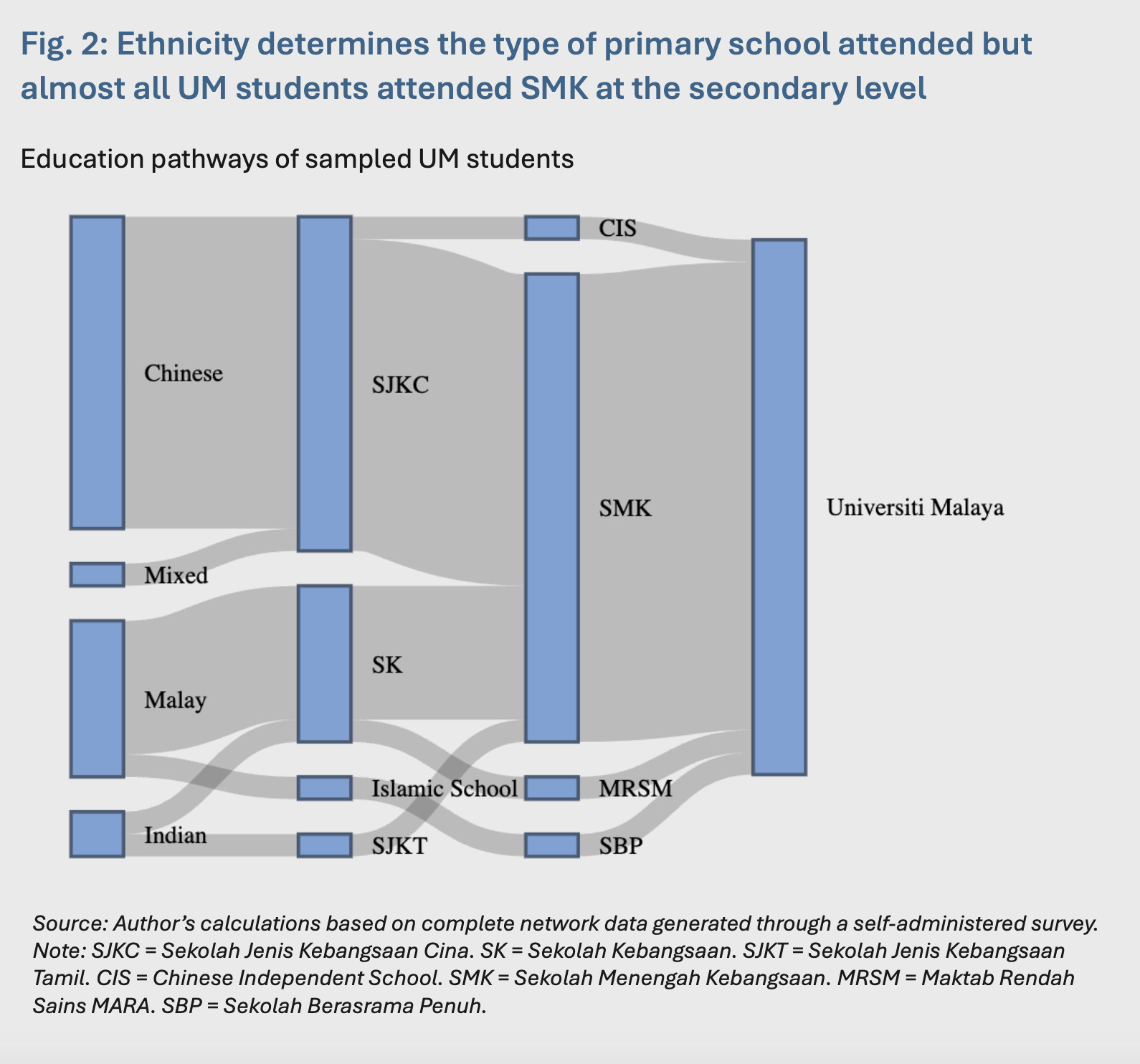
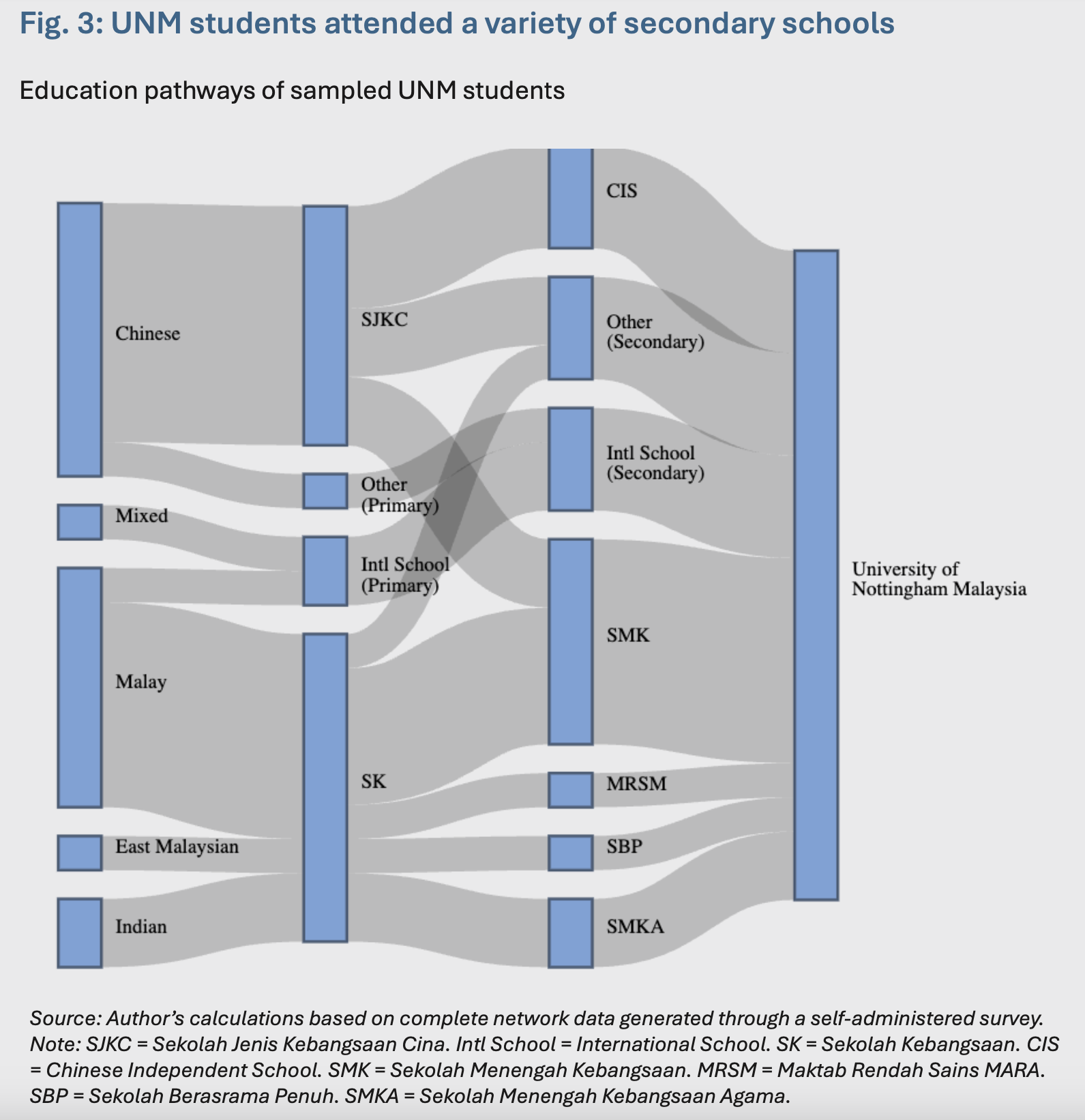
Four social networks are analysed for each university sample (Fig. 4). The first is called the closeness network, where a social tie indicates that a respondent is “very close” to a classmate. Two professional social ties are mapped in the survey: “job opening” ties (indicating whom a respondent would recommend for a job opening) and “business” ties (indicating whom a respondent would start a business with). The job opening ties and business ties produce the job opening networks and business networks, respectively for each university. The fourth network is the advice network, where a tie indicates to whom a respondent would go for advice. “Advice” in the survey can be taken ambiguously to mean advice on either personal issues or professional issues, so it captures a middle ground between the personal and professional realms depending on how the respondent perceives the question.
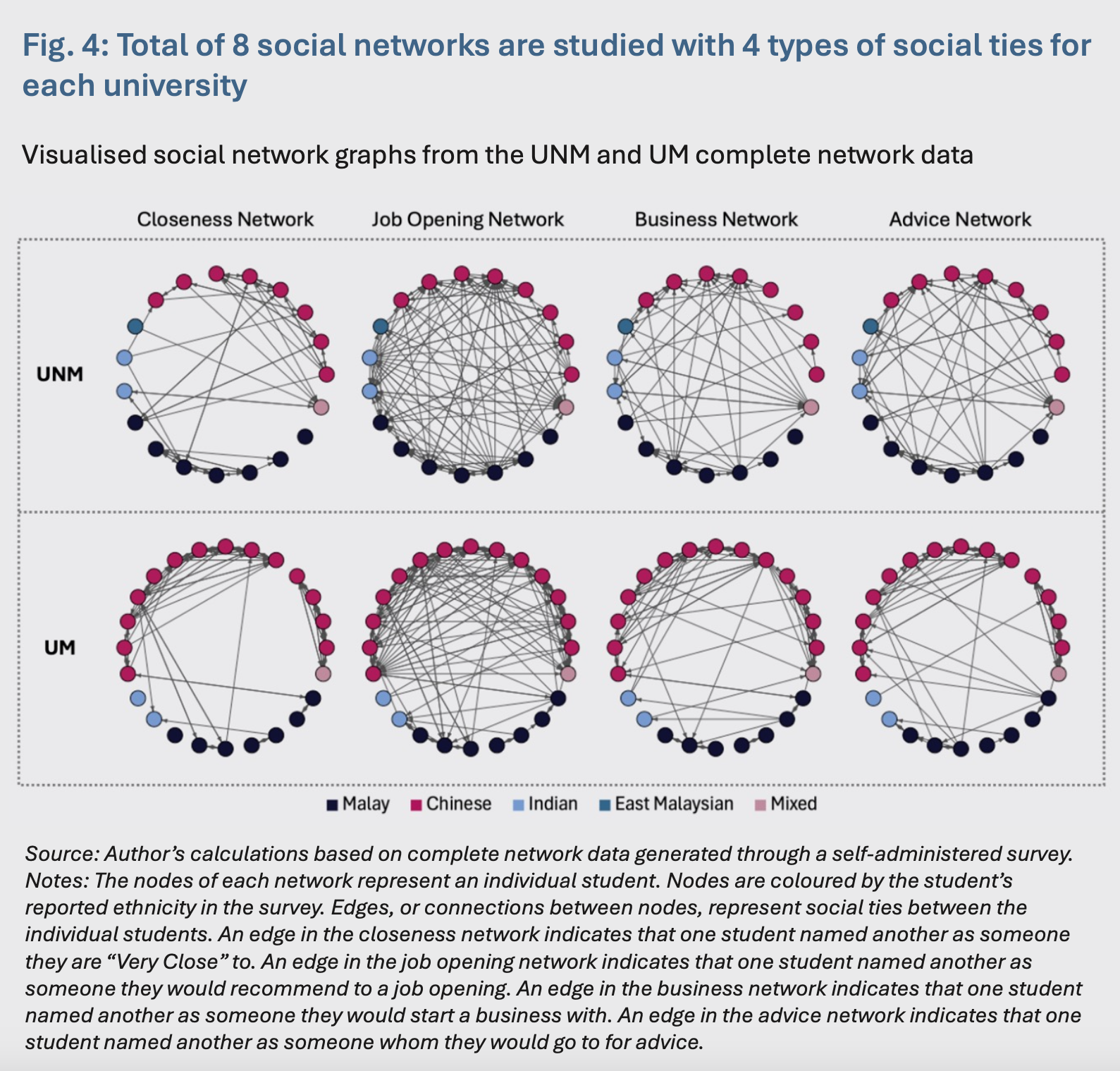
3. Analysis
3.1. Determinants of social tie formation among Malaysian students
To analyse the determinants of social-tie formation among university students, this research note uses a statistical method in social network analysis called an exponential random graph model (ERGM). In essence, an ERGM simulates the observed social network and evaluates how selected factors influence the likelihood of social ties.
This research note focuses on how shared characteristics, namely ethnicity, language and gender, influence social-tie formation among students. If the estimates from the ERGM are positive for that characteristic, that means students are more likely to form social ties with others who share that characteristic – with larger positive values indicating higher likelihood. Conversely, negative coefficients suggest that social ties are less likely to form between individuals with that shared characteristic. Additional discussion about ERGMs, statistical inference and the full results table of estimated coefficients are available in Appendix B.
Broadly, the results of the ERGM show that ethnicity, language and gender are all statistically significant predictors of at least one type of social ties. However, the set of statistically significant factors differ between the public and private university networks.
3.1.1. Ethnicity
In both universities, the odds of a closeness tie (i.e. a student naming another as someone they are “very close” to) significantly increase when two individuals are of the same ethnicity (see results for the closeness networks of UNM and UM in Fig. 5). In other words, there is a statistically significant positive ethnic homophily effect on the formation of closeness ties in both universities. This finding is not surprising given that previous studies have repeatedly shown that ethnic or racial homophily features prominently in friendship networks across the world. 11,12
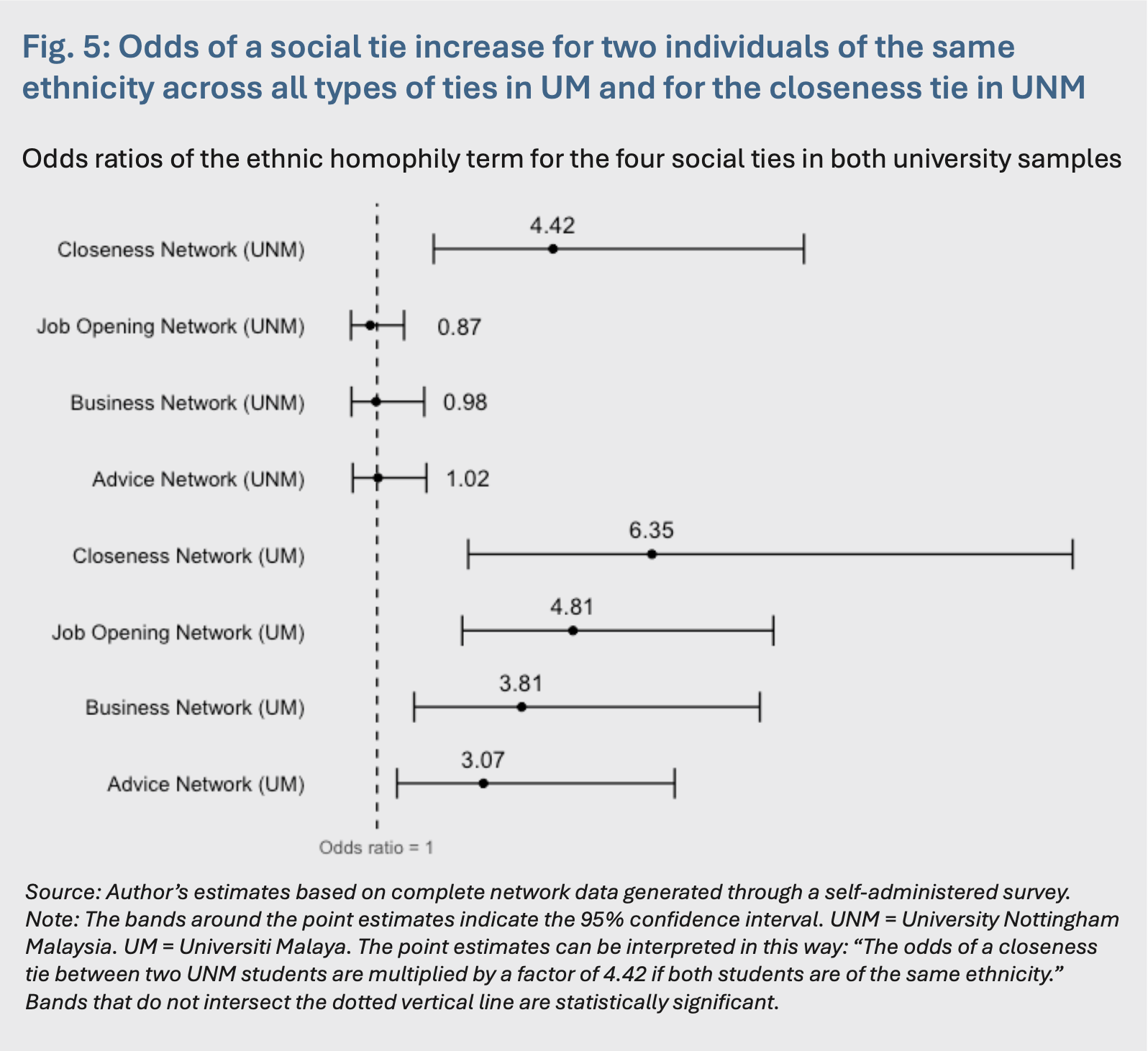
Notably, the effect of ethnic homophily on the other ties differs between public and private universities. For the public university network, ethnic homophily has a statistically significant positive effect on all social ties, whereas in the private university network, it appears to have no statistically significant effect on the formation of job opening, business or advice ties.
The non-significance of ethnic homophily in the UNM network may have emerged from two sources: a self-selection effect or a private university effect. First, more affluent students are more likely to enrol in private universities because of the significantly higher fees. Wealth or class identification could potentially replace or at least weaken ethnic identification, leading to a diminished role of ethnic homophily in the social behaviour of these private university students. Recent evidence that ethnic homophily is more prominent among individuals with greater self-identification of group status corroborates this explanation.13 Another likely explanation is that something about the private university reduces ethnic homophily among students. The university syllabus, campus activities and student demographics are all possible factors, but these have not yet been explored in the existing literature and cannot be verified with the present data.
3.1.2. Language
Another point of divergence in the results between the public and private universities is in Bahasa Malaysia homophily. In the private university, the odds of all four social ties increase significantly if two individuals speak Bahasa Malaysia fluently or as a native language, but there is no effect in the public university sample (Fig. 6). To explain this discrepancy, an alienation effect might exist in the private university but not in the public university. In the private university sample, a greater proportion of students report having “limited fluency” in Bahasa Malaysia, while all but one respondent in the public university sample report to be either “fluent” or “native/bilingual” (Fig. 7). Being in an environment where Bahasa Malaysia is less widely spoken (i.e. in a private university) makes speaking Bahasa Malaysia much more valuable, such that the likelihood that two students who speak Bahasa Malaysia form a social tie is higher. This alienation effect does not exist in the public university where Bahasa Malaysia is more widely spoken, as suggested by the data.
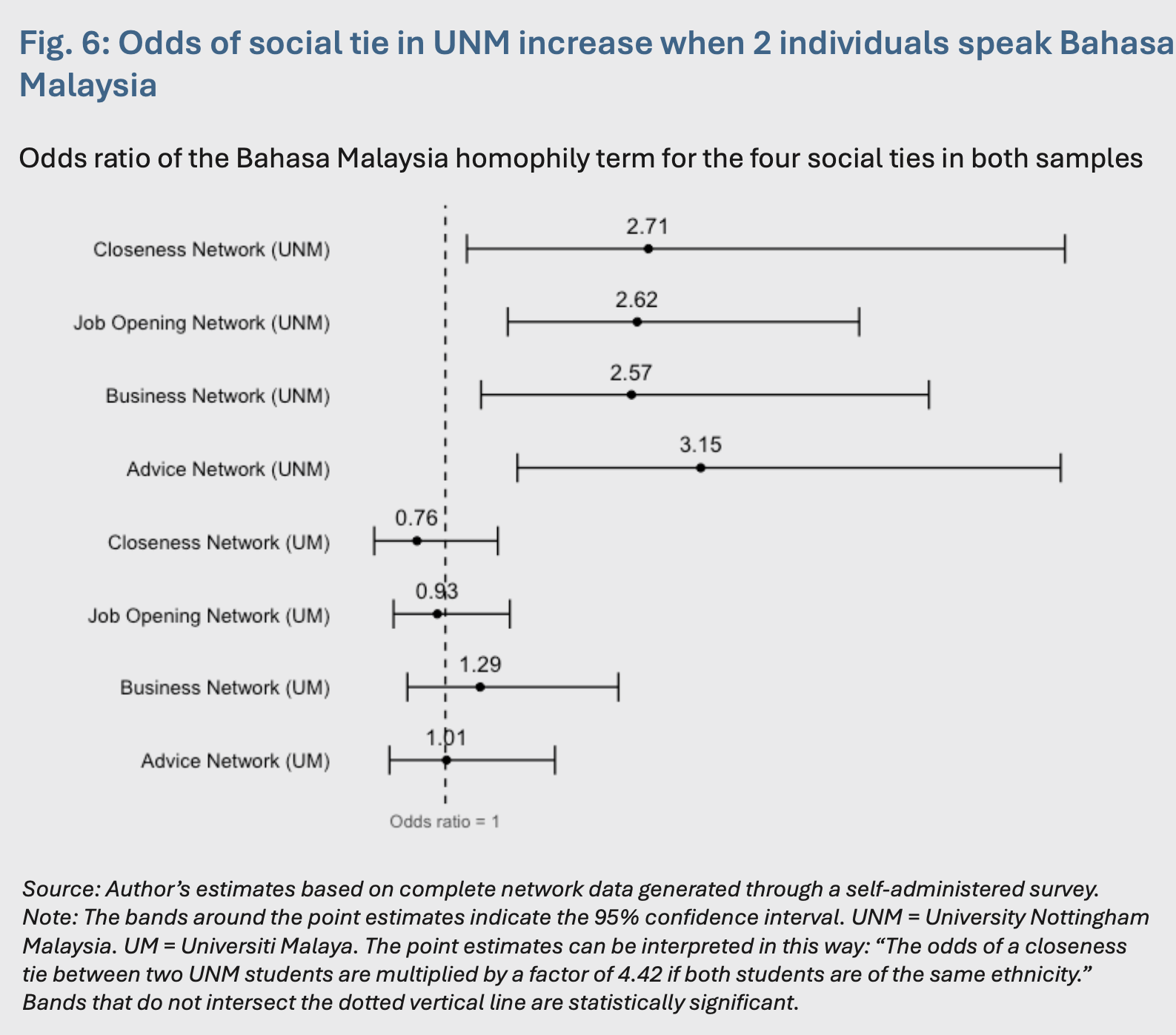
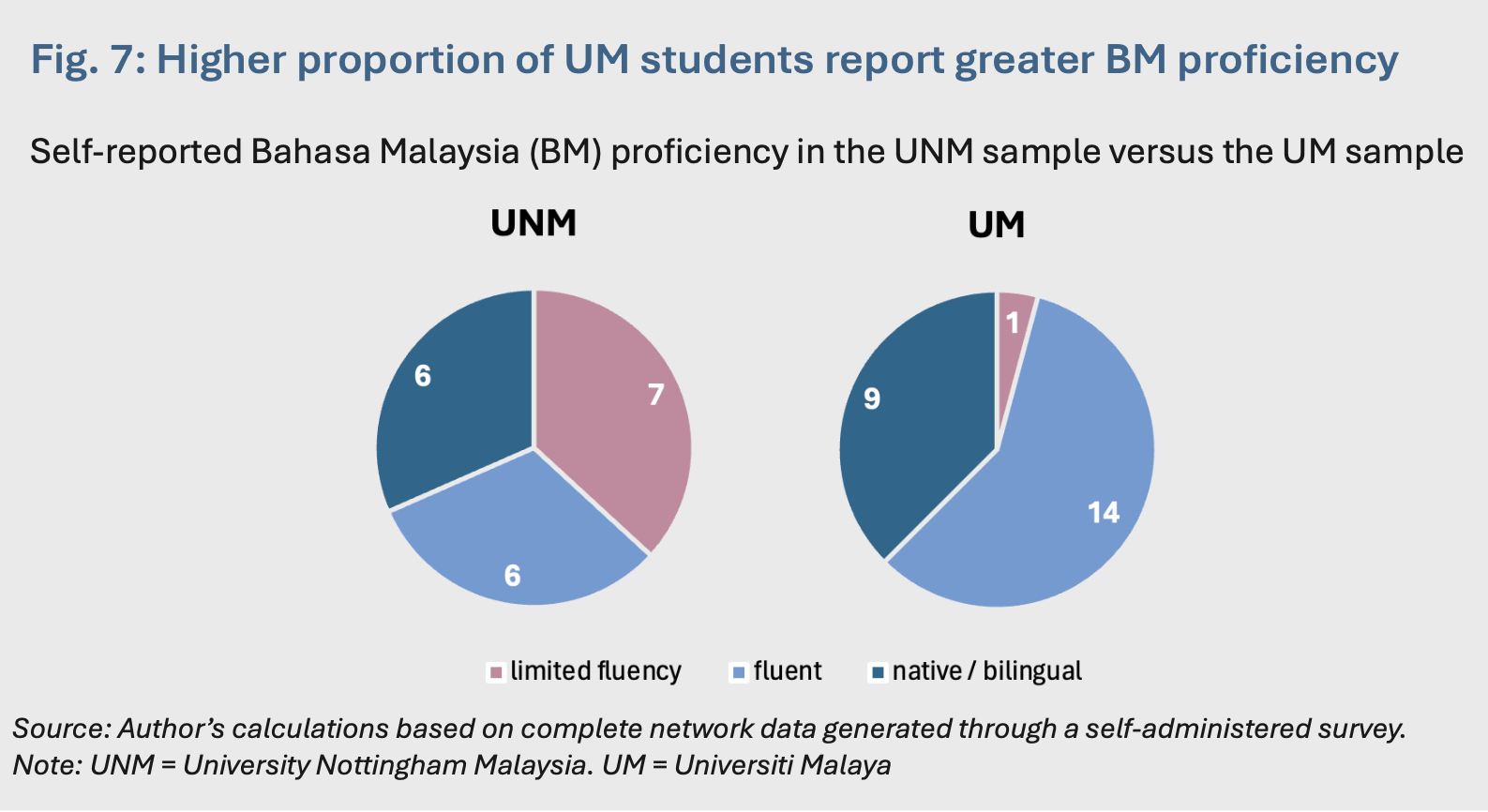
This alienation effect also explains the statistically significant Mandarin Chinese homophily observed in both universities (Fig. 8). Mandarin speakers are minorities in both universities, and thus the likelihood of a social tie between two Mandarin speakers is higher. The results also suggest that the ability to speak Mandarin Chinese remains an integral facet of building trust in the professional ties compared to closeness ties. Taken together, these findings highlight the salience of language homophily in shaping social ties, regardless of the specific language spoken.
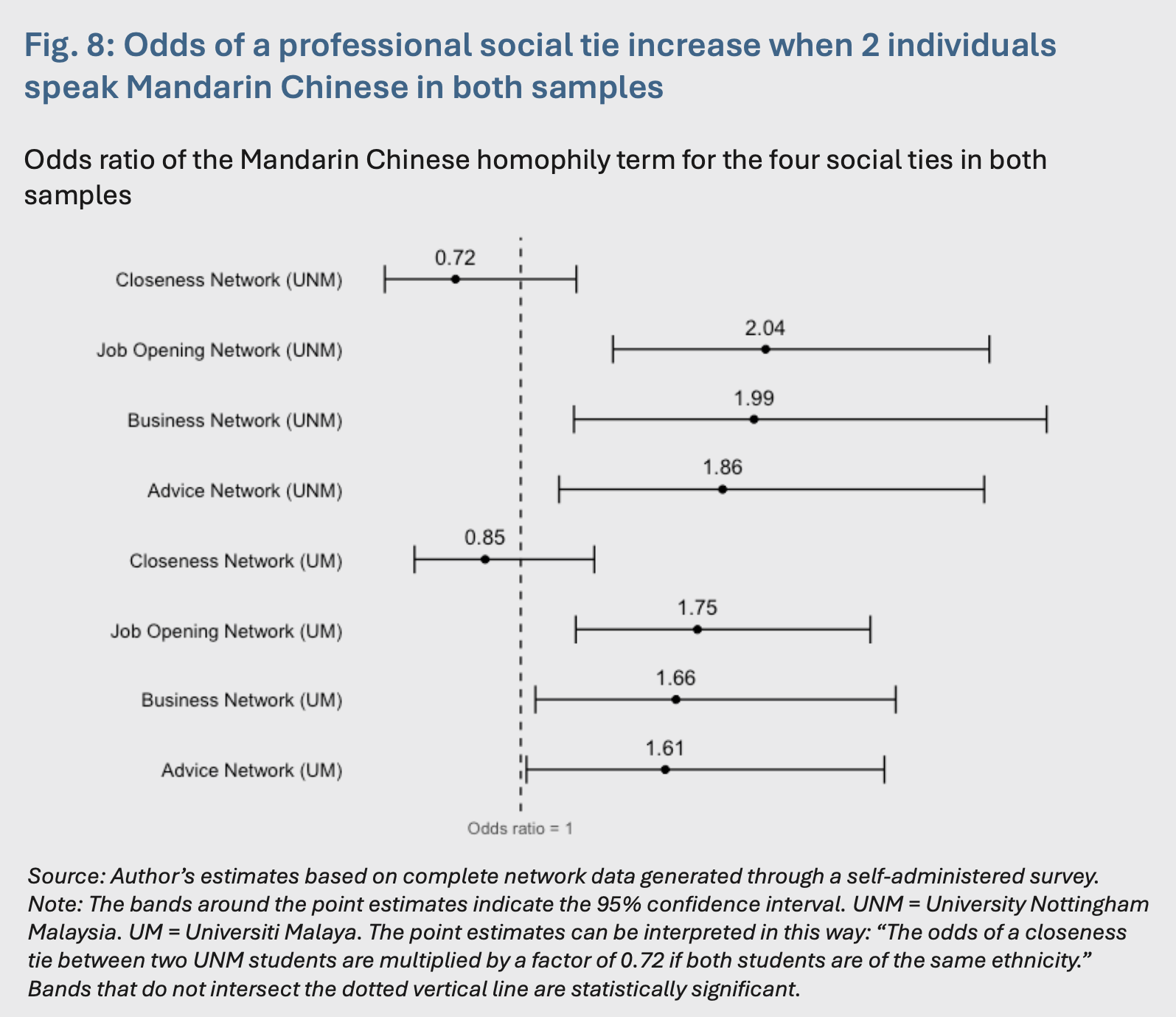
3.1.3. Gender
Finally, gender homophily is statistically significant for all types of social ties analysed except for job opening ties, which may suggest that job opening ties are more gender-blind. This could be because a recommendation to a job opening does not necessitate a commitment to the other party compared to other kinds of social ties. Being close friends and starting a business together requires commitment from both parties, while a strong relationship usually predates advice-seeking. Recommending an individual to a job opening does not require a close relationship with them and thus is one of the “weaker” social ties among the four in the survey. In this sense, gender homophily is observed in social ties that require a stronger relationship.
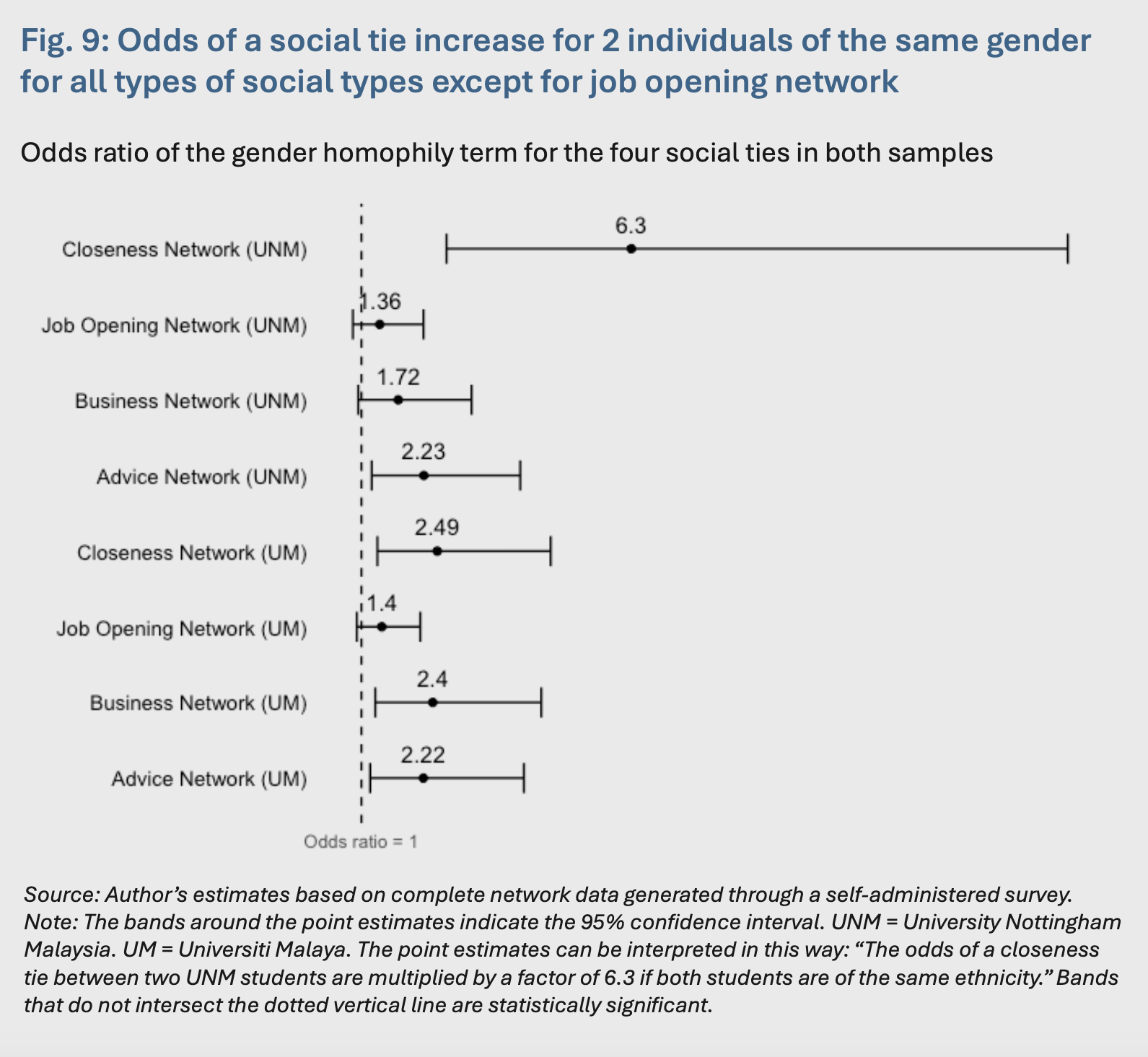
3.2. Factors that affect ethnic homophily
This section focuses on how exogenous factors could reduce or increase ethnic homophily. This is done utilising novel methods for moderation analysis of ERGM terms elaborated in Appendix C. The moderation analysis reveals two salient factors that can influence the degree of ethnic homophily: fluency in Bahasa Malaysia and students’ upbringing.
3.2.1. Bahasa Malaysia
Speaking Bahasa Malaysia moderates the effect of ethnic homophily downwards (Fig. 10). Students who report that their Bahasa Malaysia proficiency is “native/bilingual” are expected to have a lower tendency to form social ties with classmates of the same ethnicity. This result suggests that speaking a common language reduces the cost of developing social ties, thereby encouraging the formation of intergroup ties.
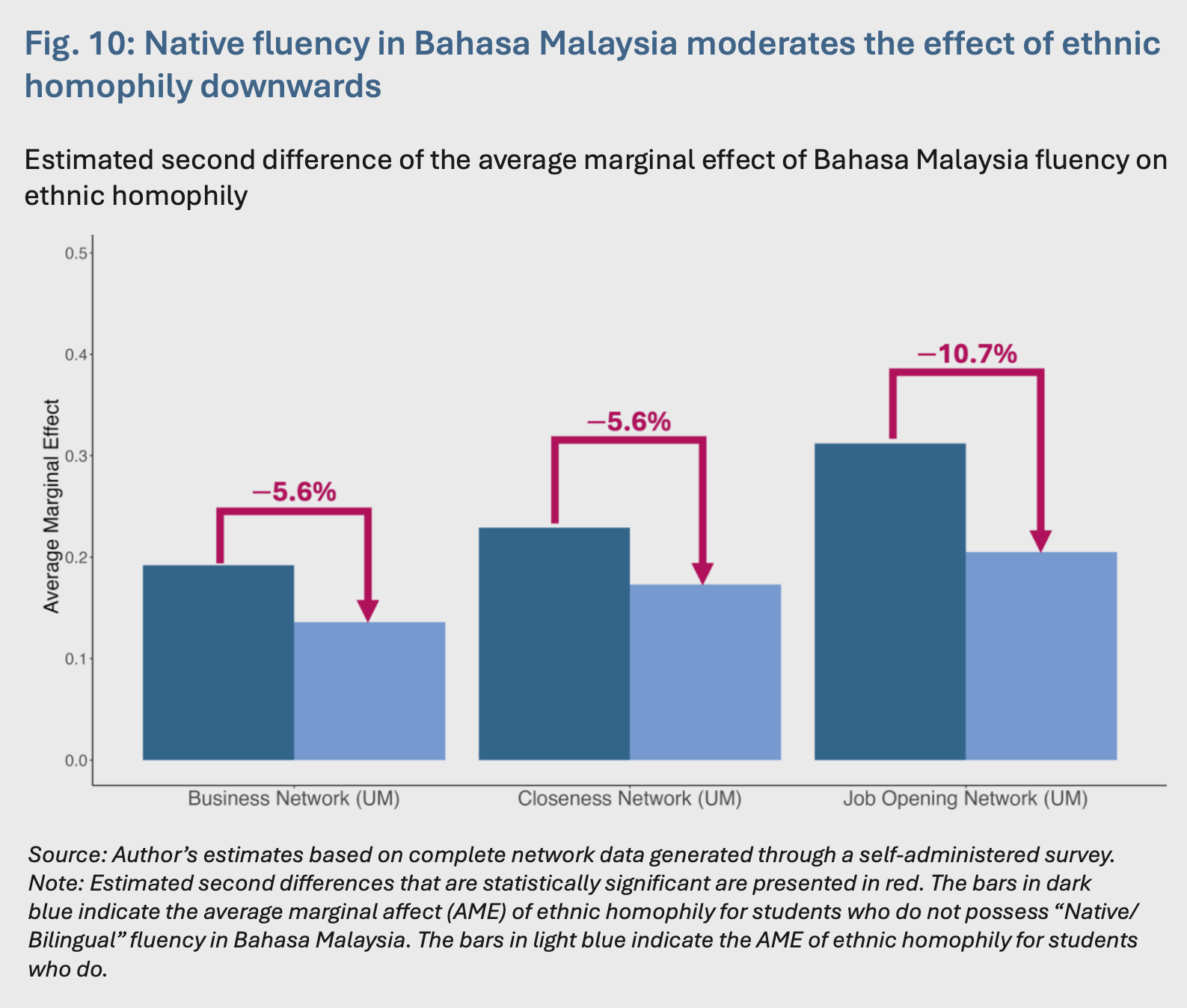
3.2.2. Upbringing
Next, we construct a variable called “upbringing” based on the district where a respondent reported to have spent most of their childhood and youth. The variable is coded with the value “one” if the respondent’s ethnicity constitutes the majority in the district, and “zero” otherwise. We then analyse how this variable affects ethnic homophily. Data on ethnic composition is obtained from the electoral roll in the 2022 general election.
Growing up in a district where most residents belong to the same ethnic group as oneself is associated with higher levels of ethnic homophily at university (Fig. 11). Being situated in a more ethnically homogenous district means that it is difficult or costly to establish social ties with those of a different ethnicity. Search frictions may be higher, and cultural familiarity remains a barrier. A lack of contact with other ethnic groups could amplify the tendency to form social ties with others of the same ethnicity at university.
Since the variable on the ethnic composition of districts is constructed using electoral data, the possibility of gerrymandering is a potential source of bias. If gerrymandering distorts electoral boundaries, then ethnic breakdown in the electoral data might not reflect the true ethnic composition in the community. However, while gerrymandering may contribute to measurement error, it is unlikely to affect the result. On average, gerrymandering produces districts that are more ethnically homogeneous than diverse. This means that respondents could be living in more ethnically diverse districts in real life than observed in the data. Under the hypothesis that growing up in a diverse district reduces ethnic homophily, we can expect the estimated effect of upbringing to be biased downwards. Since the results remain positive and statistically significant despite the potential downward bias, upbringing is likely to have a salient positive moderating effect on ethnic homophily.
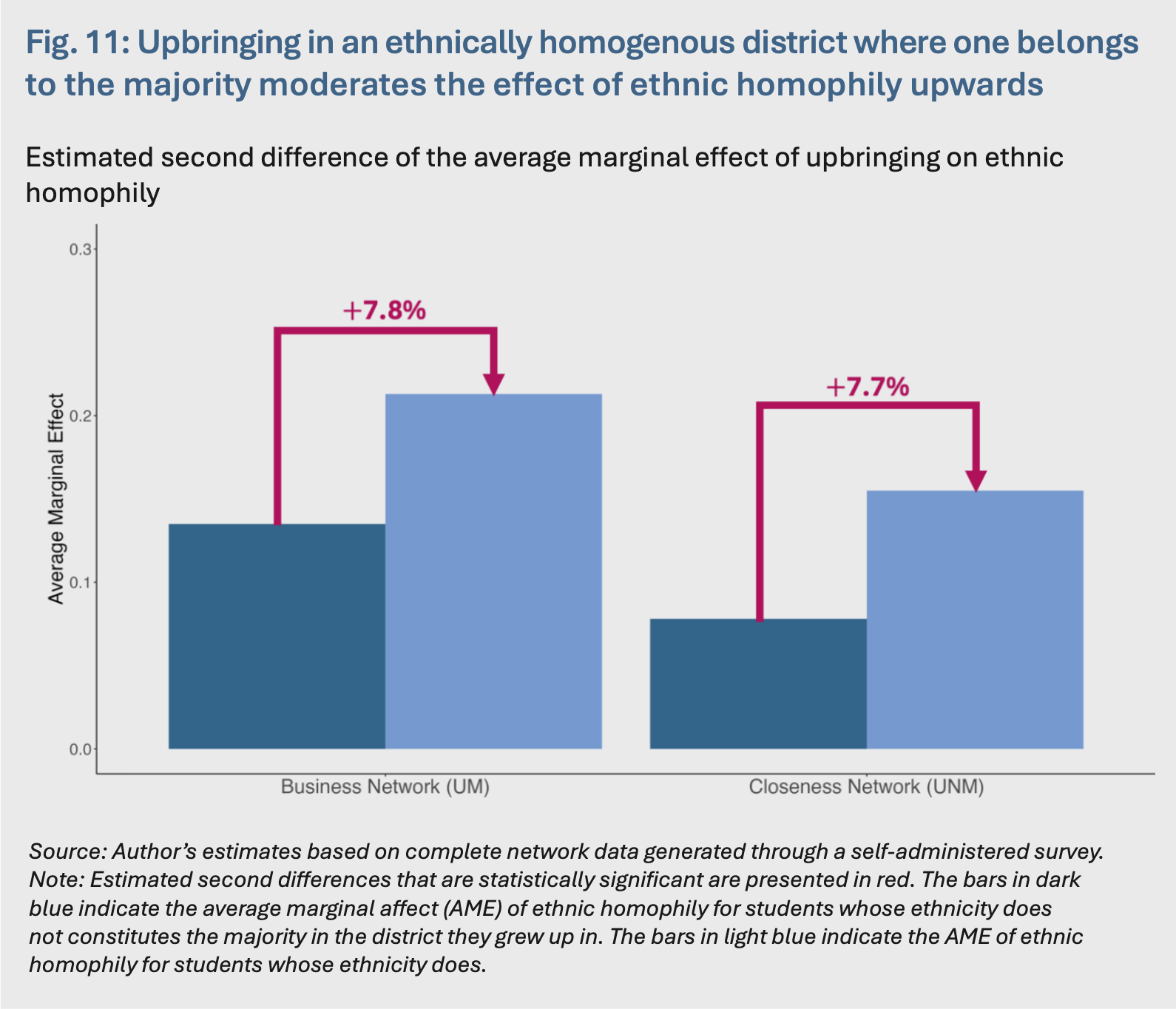
3.2.3. Gender
Finally, students in UM who identify as women exhibit significantly lower levels of ethnic homophily (Fig. 12). In other words, women are more likely to form interethnic ties than men in the sample. The gender disparity in ethnic homophily suggests fundamental differences in how men and women form social ties at university. The existing literature on gender-based differences in social-tie formation is limited. Notably, a study from the 1980s focused on school-age children and found that boys had more ethnically diverse friendships than girls,14 which is contrary to the observation in the UM sample. Investigation into the mechanisms that produce this result would shed light on how interethnic relationships might function as bridgesbetween different ethnic groups, which presents a promising direction for future research.
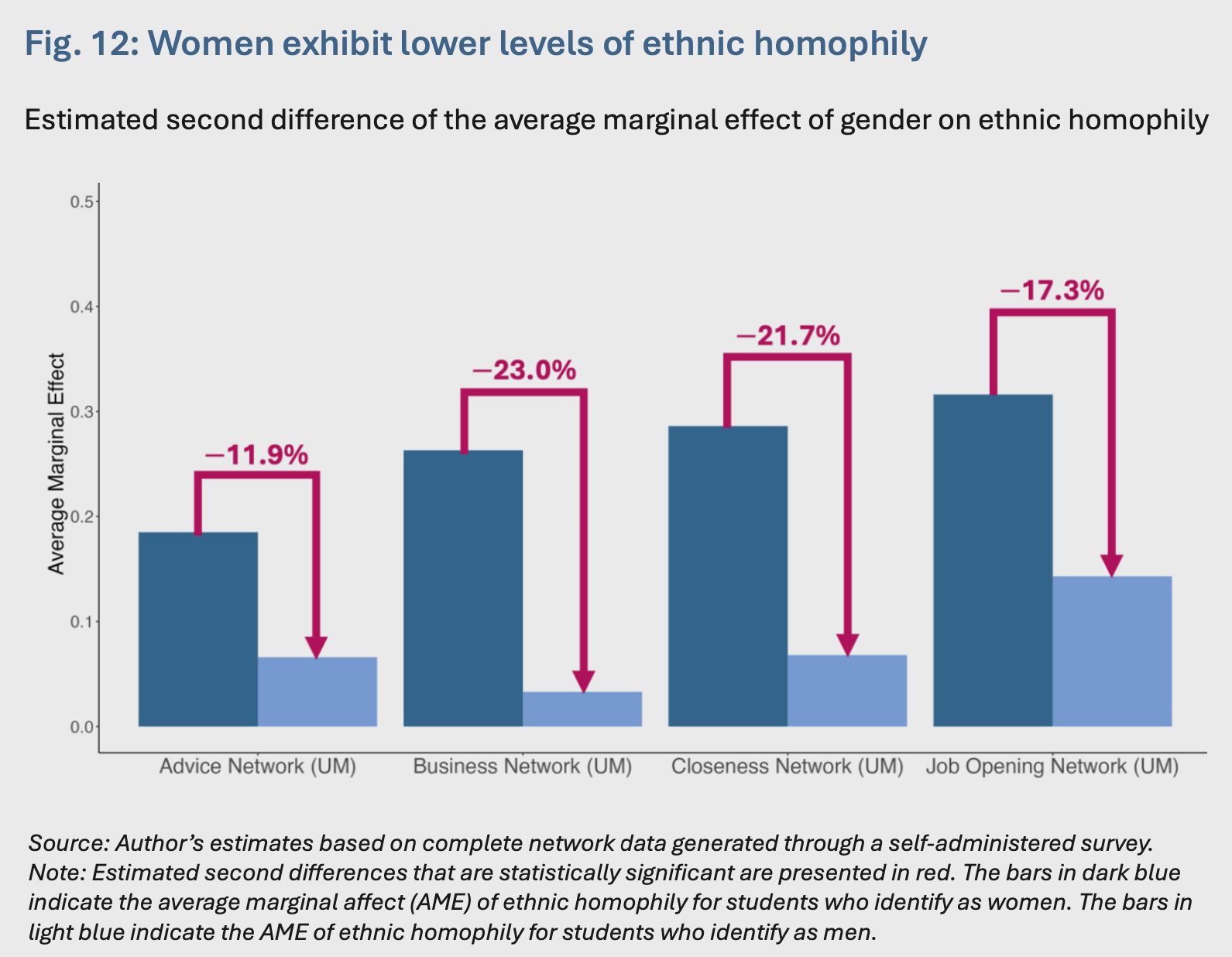
4. Conclusion
Efforts to promote national unity must recognise that social ties are the basic unit of social relations. To this end, this research note expands the evidence base showing that ethnic and language homophily are important factors that shape social-tie formation in Malaysia. The results also reveal a divergence in social-tie formation patterns between public and private universities, such as the diminished role of ethnic homophily in private universities and potential alienation effects. Further research is required to understand disparities between the two settings, but the current need for differentiated strategies to foster interethnic relations in each setting is clear.
Ultimately, policymakers must also consider the impact of language and geography when designing policies for social cohesion. Language is a double-edged sword. On the one hand, speaking the same language increases the likelihood of a social tie while speaking Bahasa Malaysia is associated with lower ethnic homophily in social ties. This implies that strategic efforts by the Education Ministry in imparting a national language (bahasa kebangsaan) and cultivating a bilingual population are effective in bringing different parts of a diverse population together.15 Moreover, the result that ethnically homogenous neighbourhoods are associated with higher levels of ethnic homophily highlights the need to address geographic ethnic enclaves. Future research could focus on the types of urban policies that could encourage more ethnically diverse communities and foster harmony within them.
Endnotes
- Lazarsfeld, P. F. & Merton, R. K. (1954). Friendship as a social process: a substantive and methodological analysis. In Freedom and Control in Modern Society, ed. M Berger, pp. 18–66. New York: Van Nostrand.
- McPherson, M., Smith-Lovin, L., & Cook, J. (2001). Birds of a Feather: Homophily in Social Networks. Annual Review of Sociology, 27, 415.
- Smith, J. A., McPherson, M., & Smith-Lovin, L. (2014). Social Distance in the United States: Sex, Race, Religion, Age, and Education Homophily among Confidants, 1985 to 2004. American Sociological Review, 79(3), 432–456.
- Jackson, M. O. (2021). Inequality’s Economic and Social Roots: The Role of Social Networks and Homophily (SSRN Scholarly Paper 3795626).
- DiMaggio, P., & Garip, F. (2012). Network Effects and Social Inequality. Annual Review of Sociology, 38(1), 93–118.
- Yeoh, E. K.-K. (2006). Ethnic coexistence in a pluralistic campus environment. GeoJournal, 66(3), 223–241.
- Tey, N. P., Halimah, A., & Singaravelloo, K. (2009). Ethnic interactions among students at the University of Malaya. Malaysian Journal of Economic Studies, 46, 53–74.
- Marmaros, D., & Sacerdote, B. (2006). How Do Friendships Form?.The Quarterly Journal of Economics, 121(1), 79–119.
- Wasserman, S., & Faust, K. (1994). Social Network Analysis: Methods and Applications. Cambridge University Press.
- Wasserman, S., Faust, K., 1994. Social Network Analysis: Methods and Applications, Structural Analysis in the Social Sciences. Cambridge University Press, Cambridge.
- McPherson, M., Smith-Lovin, L., & Cook, J. (2001). Birds of a Feather: Homophily in Social Networks. Annual Review of Sociology, 27, 415.
- Smith, J. A., McPherson, M., & Smith-Lovin, L. (2014). Social Distance in the United States: Sex, Race, Religion, Age, and Education Homophily among Confidants, 1985 to 2004. American Sociological Review, 79(3), 432–456.
- Leszczensky, L., & Pink, S. (2019). What Drives Ethnic Homophily? A Relational Approach on How Ethnic Identification Moderates Preferences for Same-Ethnic Friends. American Sociological Review, 84(3), 394–419.
- Maccoby, E. E. (1999). The Two Sexes: Growing Up Apart, Coming Together. Cambridge, MA: Harvard University Press
- Ministry of Education Malaysia. (2013). Malaysian Education Blueprint 2013 – 2015. Putrajaya: Kementerian Pendidikan Malaysia.
- Hunter, D. R., Handcock, M. S., Butts, C. T., Goodreau, S. M., & Morris, M. (2008). ergm: A Package to Fit, Simulate and Diagnose Exponential-Family Models for Networks.Journal of Statistical Software, 24(3), nihpa54860.
- Duxbury, S. W. (2023). The Problem of Scaling in Exponential Random Graph Models. Sociological Methods & Research, 52(2), 764–802.
- Duxbury, S. W. (2019). Mediation and Moderation in Statistical Network Models. SocArXiv, Article 9bs4u.
- Chong, Z. Z. (2023). Interethnic Friendships Under Ethnically Segregation Pathways in Education: The Case of Malaysia. Unpublished.
References
Chong, Z. Z. (2023). Interethnic Friendships Under Ethnically Segregation Pathways in Education: The Case of Malaysia. Unpublished.
DiMaggio, P., & Garip, F. (2012). Network Effects and Social Inequality. Annual Review of Sociology, 38(1), 93–118.
Duxbury, S. W. (2019). Mediation and Moderation in Statistical Network Models. SocArXiv, Article 9bs4u.
Duxbury, S. W. (2023). The Problem of Scaling in Exponential Random Graph Models. Sociological Methods & Research, 52(2), 764–802.
Hunter, D. R., Handcock, M. S., Butts, C. T., Goodreau, S. M., & Morris, M. (2008). ergm: A Package to Fit, Simulate and Diagnose Exponential-Family Models for Networks. Journal of Statistical Software, 24(3), nihpa54860.
Jackson, M. O. (2021). Inequality’s Economic and Social Roots: The Role of Social Networks and Homophily (SSRN Scholarly Paper 3795626).
Lazarsfeld, P. F., Merton, R. K. (1954). Friendship as a social process: a substantive and methodological analysis. In Freedom and Control in Modern Society, ed. M Berger, pp. 18–66. New York: Van Nostrand.
Leszczensky, L., & Pink, S. (2019). What Drives Ethnic Homophily? A Relational Approach on How Ethnic Identification Moderates Preferences for Same-Ethnic Friends. American Sociological Review, 84(3), 394–419.
Maccoby, E. E. (1999). The Two Sexes: Growing Up Apart, Coming Together. Cambridge, MA: Harvard University Press
Marmaros, D., & Sacerdote, B. (2006). How Do Friendships Form? The Quarterly Journal of Economics, 121(1), 79–119.
McPherson, M., Smith-Lovin, L., & Cook, J. (2001). Birds of a Feather: Homophily in Social Networks. Annual Review of Sociology, 27, 415.
Ministry of Education Malaysia. (2013). Malaysian Education Blueprint 2013 – 2015. Putrajaya: Kementerian Pendidikan Malaysia.
Smith, J. A., McPherson, M., & Smith-Lovin, L. (2014). Social Distance in the United States: Sex, Race, Religion, Age, and Education Homophily among Confidants, 1985 to 2004. American Sociological Review, 79(3), 432–456.
Tey, N. P., Halimah, A., & Singaravelloo, K. (2009). Ethnic interactions among students at the University of Malaya. Malaysian Journal of Economic Studies, 46, 53–74.
Wasserman, S., & Faust, K. (1994). Social Network Analysis: Methods and Applications. Cambridge University Press.
Yeoh, E. K.-K. (2006). Ethnic coexistence in a pluralistic campus environment. GeoJournal, 66(3), 223–241.
APPENDICES
Appendix A: Survey methodology
The Year 4 Economics class at Universiti Malaya (UM) and the Year 3 Economics class at the University of Nottingham Malaysia (UNM) were selected as the target population to study. Students from the same class in the same year of study were sampled to ensure that the sampled respondents had a common social locus for interacting. These students are expected to largely attend the same classes and social events, and thus have opportunities to meet and form social ties. Only final-year students were selected because they would have had the most time to form connections within their class compared to students with fewer years of study.
We utilised a two-step sampling process, starting with an interest registration form and later administering a social-tie mapping survey. Gathering interest from eligible respondents ensures balance and representativeness in the sample before commencing the social-tie mapping survey. Two separate interest registration forms were broadcasted into the WhatsApp group chats of both selected university classes respectively. In the interest registration form, potential respondents who indicated willingness to participate in the survey were asked to fill out their contact details as well as both their full names and the name that their friends know them by. These names were used in the later survey. The form also collected demographic information, such as ethnicity, primary school attended, secondary school attended, pre-university, postcode and proficiency level in four languages (Bahasa Malaysia, English, Mandarin Chinese and Tamil). Collecting demographic information in this part of the survey helps to make the subsequent survey less bloated.
The aim was to recruit at least 20 respondents, such that the total possible combinations of dyads amounted to 190.

A total of 40 registrations from UM and 23 registrations from UNM were received. We removed individuals who were not Malaysian or who were not from the selected class. After filtering out ineligible participants, the final number amounted to 28 from UM and 20 from UNM.
After closing the interest registration form, eligible respondents were contacted with an invitation to fill out the social-tie mapping survey. The survey forms contained 4 sections and are identical for both universities. In the first section, respondents were asked to identify themselves by selecting their names from a drop-down list of names collected from the interest registration form. In the second section, respondents indicated whether they were “Very Close”, “Moderately Close” or “Not Close At All” with each of their classmates who entered the survey. In the next three sections, respondents were asked to select the names of their classmates whom they would go to for advice, recommend to a job opening and start a business with.
The final network samples consist of 19 and 24 students for the UNM and UM samples respectively. The number of students in the network is lower than the number of eligible respondents due to respondent attrition – a few students who filled up the interest registration form did not complete the social-tie mapping survey. Respondents who dropped out were removed from the final sample.
There are sampling challenges that might have implications on the generalisability of the results, particularly for the UM sample. There are a total of 199 students in the Year 4 Economics class at UM, which means that a mere 12% of the class (24 out of 199) entered the survey. The results generated from a sample of 24 might not necessarily be indicative of true social relations in the UM class. On the other hand, 19 out of 21 eligible respondents in the Economics Year 3 class in UNM entered the survey, which means that the results likely paint an accurate picture of social relations in the class.
Appendix B: Exponential random graph models
Exponential random graph models (ERGMs) model the probability of observing the network as a function of network features.16 It is a statistical modelling technique that creates simulations of an observed social network with all its network features, including individual characteristics like gender, ethnicity and language; interactions between students, like whether the two nodes share similar characteristics or how two nodes differ (for example, the age difference between two individuals); and structural features of the network, such as patterns of two-way connection (reciprocity) and friends of friends (transitivity).
Functionally, an ERGM estimates the effect of network features on the probability that an edge (i.e. social tie) exists between two nodes, keeping all other aspects of the network unchanged. An ERGM outputs coefficients and standard errors for the effect of these network features, which means it is possible to conduct standard statistical inferences on the relationship between network features and the network.
In this research, the key network features of interest are the homophily variables. These can be interpreted as the increase in the odds of observing the given network in response to two individuals sharing the same characteristic, be it ethnicity, gender or speaking the same language, holding the rest of the network fixed. A positive coefficient implies that a social-tie is more likely between two individuals who share that attribute, with larger positive values indicating a greater likelihood of social tie formation. Conversely, a negative coefficient would imply that a social tie is less likely between two individuals who share that characteristic. The homophily coefficients of interest in this research are those of ethnicity, language and gender.
Appendix C: Moderation analysis of ERGM terms
Recent innovations in social network analysis enable the analysis of changes in the ethnic homophily term in response to a change in an exogenous variable, called a moderator variable. Before conducting the moderation analysis, the ERGM estimates must be interpreted in average marginal effects (AME) to overcome issues with scaling.17 The problem of scaling arises because ERGM estimates are denominated in log scale while changes in the moderating variables are in levels. Estimates obtained from interacting terms in log scale and terms in levels are biased due to scaling; however, the predictions from ERGM are not affected.18 This property allows moderation analysis to be conducted by interpreting ERGM coefficients in terms of the AME. Consequently, the results are expressed as changes in the probability of forming a social tie rather than changes in the log odds.
Moderation analysis produces the estimated second difference, which is the difference in the AME of ethnic homophily when the moderating factor increases by one unit. Table 2 presents the results of the moderation analysis on networks where ethnic homophily has a statistically significant coefficient (i.e. the private university closeness network and networks for all four social ties in the public university sample). An explanation of how to interpret the estimated second differences is included in the notes under Table 2.
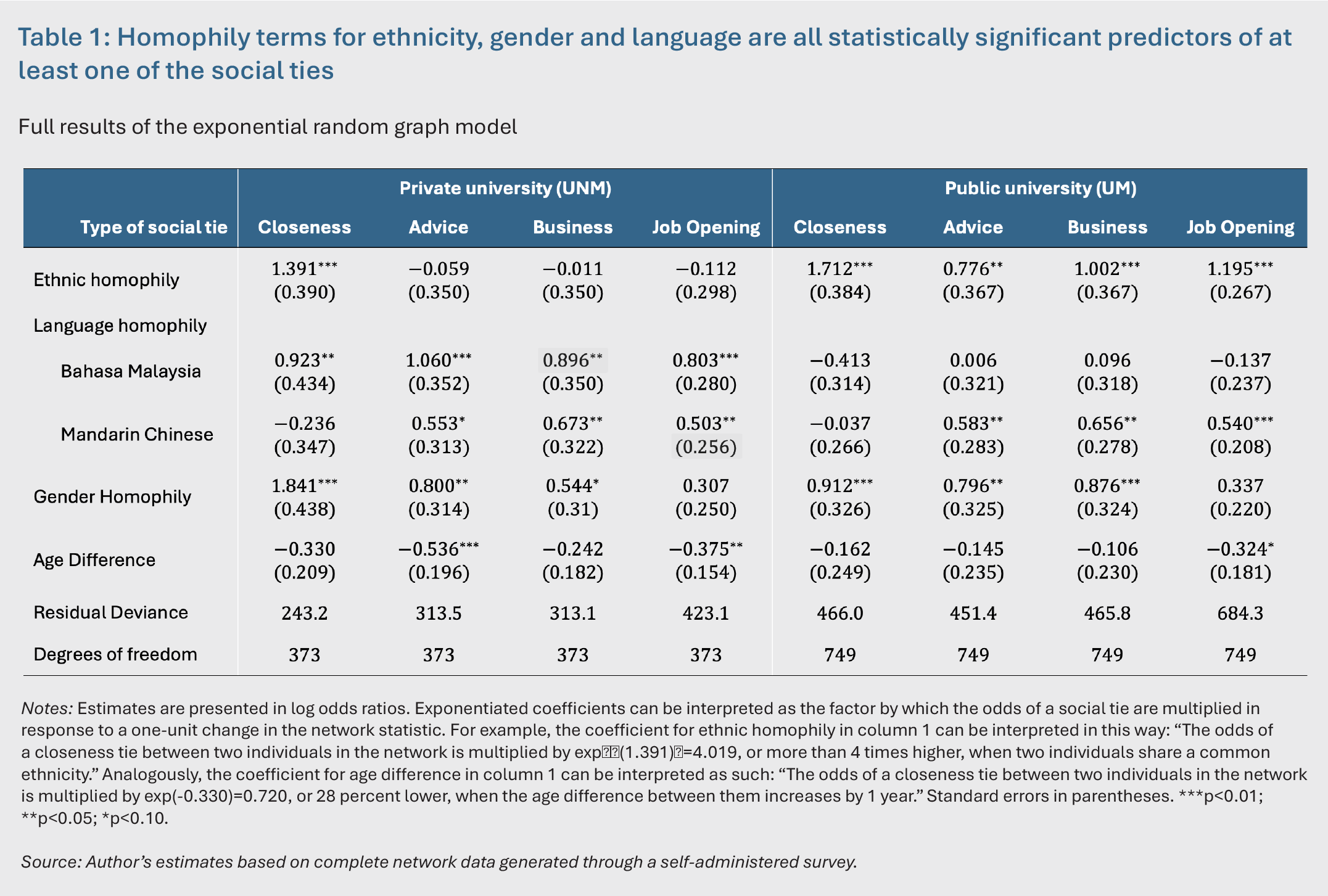
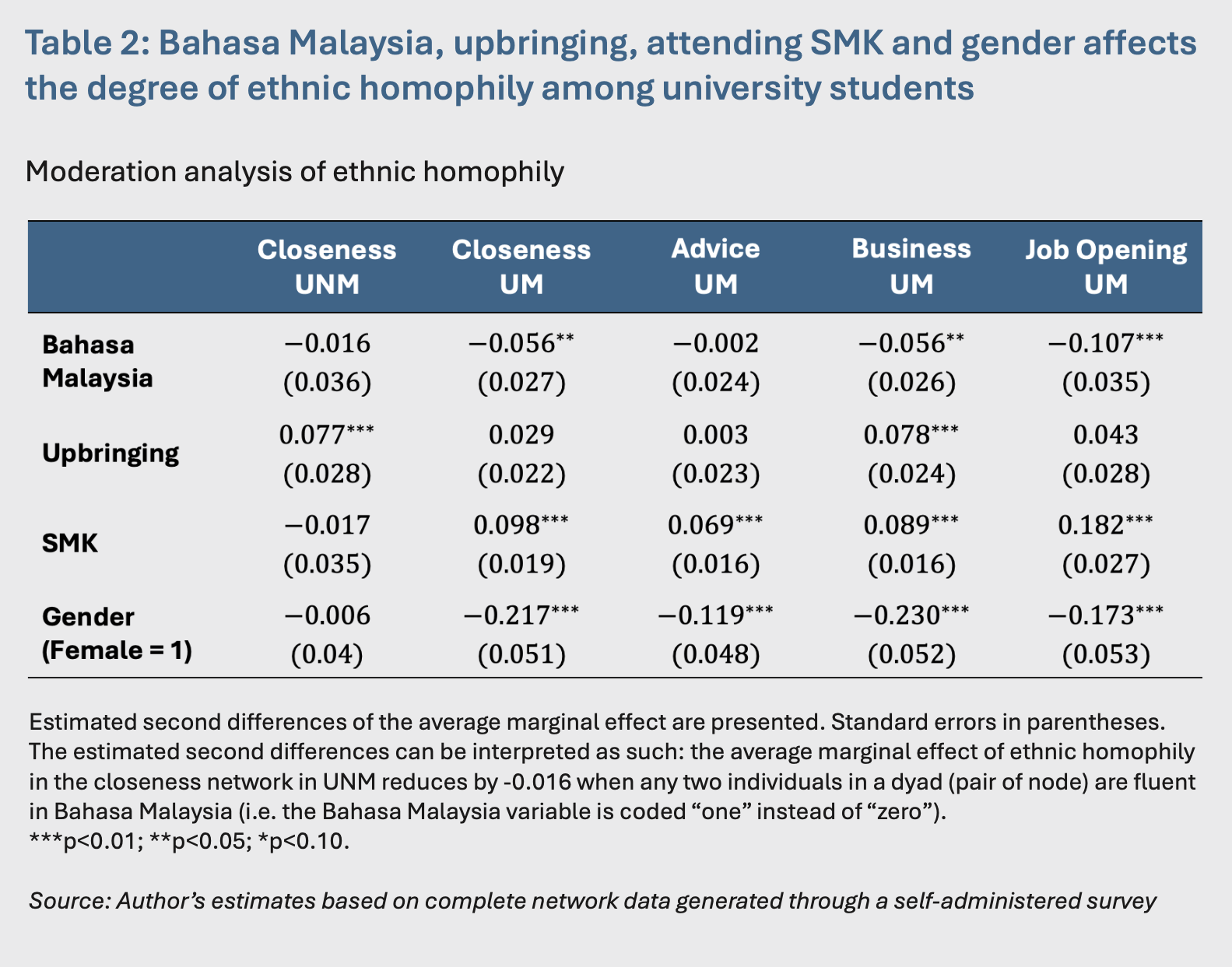
The moderation analysis also indicates that attending SMK increases the effect of ethnic homophily, but only for the public university sample. The UM students who went to SMK exhibit greater levels of ethnic homophily. This finding deviates from a previous study that found that attending SMK is associated with lower levels of ethnic homophily.19 This is counterintuitive for two reasons. Relatively greater ethnic diversity in SMK is expected to reduce the effect of ethnic homophily and national schools are expected to instil a sense of national identity which should promote more intergroup ties. The result here should be interpreted with caution because there is very limited variation in the data on the types of secondary schools attended by UM students. All but three UM students in the sample went to SMK. The lack of variation in the data may have conflated the effect of SMK on ethnic homophily with the effect of ethnic homophily itself.



